As the world continues to shift towards online-first data, for everything from their remote workplace to streaming their favorite shows on Netflix, it’s become more imperative to recognize that “live” data needs to be handled with extra special care in an asynchronous system.
Asynchrony is needed in order to enable the parallel use of computing resources, on collaborating network hosts with a single streamline data engine.
The primary goal of Reactive Streams is to govern the exchange of stream data across an asynchronous boundary — similar to passing elements on to another thread or thread-pool in traditional transfer — while ensuring that the receiving side isn’t forced to buffer arbitrary data.
Meaning… Reactive Streams allow for MULTIFOLD data processing, as opposed to traditional models, leaving more room for faster response times and a smoother UX experience.
Functional Style Programming
Functional Programming languages are specially designed to handle symbolic computation and list processing applications. It is a declarative type of programming style with a main focus on “what to solve” in contrast to “how to solve” (an imperative style).
Reactive Programming by nature embraces a functional programming style. It functions similarly to common programmer staples such as Steams API and Lambdas, making it a smooth integration curve.
Reactive Streams And Backpressure
Backpressure happens when data can’t render as fast as it needs to. This can cause a “buildup” of data at the I/O Switch when buffers are full and cannot receive additional data. At this point, no additional data packets can be transferred until the bottleneck of data has been eliminated or the buffer has been emptied.
Reactive Streams disrupt buildup by supporting the back-pressure so they can signal the database to “hold off” on producing more output, or in other words– “buffer” until the remaining data is processed… Making for a smoother UX experience for the interface user and a more cohesive data transfer for the programming system.

Popular Reactive Libraries
RxJava

RxJava is a specific implementation of reactive programming for Java and Android that is influenced by functional programming. It favors function composition, avoidance of global state and side effects, and thinking in streams to compose asynchronous and event-based programs.
Project Reactor

Reactor Core is a Java 8 library that implements the reactive programming model. It’s built on top of the Reactive Streams specification, a standard for building reactive applications.
Flow API

Flow API is the official support for reactive streams specification since Java 9. It is a combination of both Iterator and Observer patterns.
Flow API consists of four basic interfaces:
- Subscriber: The Subscriber subscribes to Publisher for callbacks.
- Publisher: The Publisher publishes the stream of data items to the registered subscribers.
- Subscription: The link between publisher and subscriber.
- Processor: The processor sits between Publisher and Subscriber, and transforms one stream to another.
Test Your Skills
You’ve unpacked quite a few introductory principles — think you’re up to exploring a live demonstration of these concepts in play?
Hirav Oza has crafted an intuitive demonstration to help guide you through these principles in practicum:

Be sure to follow Oza’s entire Lightning Talk to view this impressive demonstration in real time.
Closing Thoughts
All programs should always be designed with performance and the user experience in mind. The properties explored above are the primary stepping stones to exploring the basic components needed to test how Reactive Streams can improve your personal data application. Be sure to explore, have fun, and match up the components that work best for your project!
Happy coding!
To learn more about Reactive Streams in web development and to experience Hirav Oza’s full Lightning Talk session, watch here.